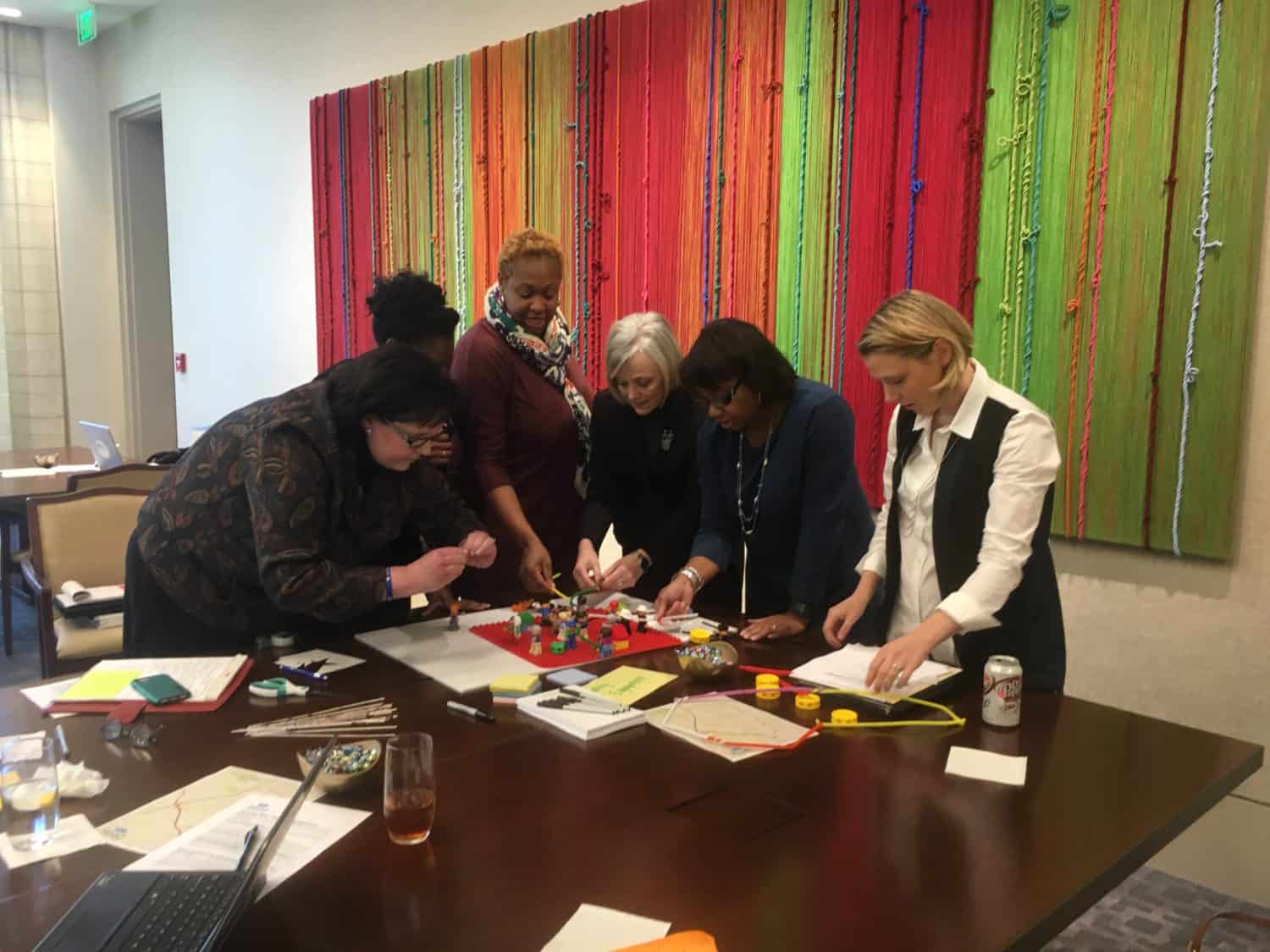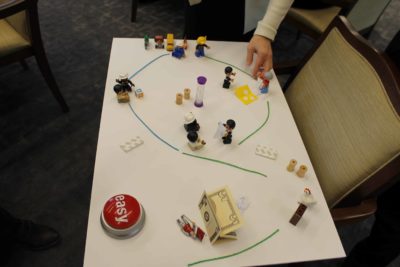The 18 women sit around a U-shaped arrangement of folding tables, eating Domino’s pizza and Girl Scout cookies. White binders are open in front of them, and many scribble notes on sheets of loose-leaf paper. It is approaching 7 p.m. on this winter Tuesday; most of the teachers have been on the clock for nearly 12 hours.
“We’ve got third graders and fifth graders that read like four-year-olds,” says Darlene, a veteran teacher at Albemarle Road Elementary School, a Title I campus on Charlotte’s east side. “They know how to open the book, but they don’t know what the words are.” Charlotte-Mecklenburg Schools has identified 77 Title I schools this year.
Darlene has come, with other public school and private preschool teachers, to this Read Charlotte seminar—a “Train the Trainer” exercise—to learn how to lead an active reading workshop to help parents turn story time into education. Read Charlotte plans to host at least seven active reading workshops during the 100 Day Challenge and wants to train 500 families in active reading skills this calendar year, building to the point at which 51 percent of Charlotte-Mecklenburg children participate in active reading three times per week. Each workshop consists of four sessions, spread across a month, that spotlight techniques families can use at home to build language, vocabulary, and reading comprehension skills.
At the front of the room, Samantha Cleaver, Read Charlotte’s research assistant, bounces on the balls of her feet. “We can tell parents to talk—and we should—but we gotta tell them how to talk,” Cleaver says.
Starting at 16 months until age five, children can learn up to 10 new words per day. But often, parents use the same, limited vocabulary when speaking to their kids. We say “tummy,” for example, over and over and over—which is fine, but doesn’t expose children to the words “stomach” or “abdomen.”
Cleaver points to a chart on the screen. It shows the rate of rare words used per 1,000 words of speaking. Adults talking to three-year-old children use nine rare words per 1,000 words spoken. A conversation between college graduates includes just 17. But children’s books contain 31 rare words per 1,000 words.
“Teaching people how to use children’s books will get us those rare words we need,” Cleaver says. Reading out loud can dramatically increase a child’s vocabulary, which in turn boosts literacy.
What, one teacher asks, is a rare word?
“These are two- to five-year-olds,” Cleaver responds. “Any word that’s new to them is a rare word.”
A key tenet of Read Charlotte’s work is that children are more successful in school when their families know how to reinforce language and literacy skills at home. “As adults, reading has become so automatic that we don’t know how to pass it along,” Cleaver says. I contemplate this point and realize the truth in it—I couldn’t begin to tell you how I would teach my niece to read beyond sitting her in my lap with a Dr. Seuss book.
Cleaver walks the group through a handful of active reading strategies, using Where the Wild Things Are as an example. She reads a page aloud. “Max is on a private boat.”
A parent reading this story to a child should ask questions: What does private mean? Why do you think Max is on a private boat? Max is on a _________ boat, what is this word? The idea is to get parents and kids using and saying unfamiliar words, to connect them to context, and to relate them to real-life experiences. Simply reading the book aloud and turning the pages is not good enough. Instead of reading to make a kid sleepy before naptime, parents should have conversations with children, using books to change behaviors and outcomes.
Active reading strategies require thought; parents have to be fully engaged in reading as a learning activity and not just as a momentary entertainment, Cleaver says. It is reading with your child, not reading to her.
The session makes clear that if Mecklenburg County is going to double its third grade reading proficiency in a decade, the responsibility can not fall on a single entity. Charlotte-Mecklenburg Schools can not go it alone; anyone who engages with a child can (and should) be able to make an impact on his or her reading proficiency. Read Charlotte can not rely on pulling a single lever to yield change.
It has endorsed a range of initiatives—a program that hands out free books at pediatricians’ offices, out-of-school tutoring, active reading workshops sponsored by the public library system—designed to boost reading skills. It supports a text messaging service that sends reading tips to parents. Read Charlotte has identified five interventions that research indicates are effective a growing a child’s ability to read:
- Active reading with children, which can show results as quickly as six weeks and offers four-and-a-half months of additional learning growth compared to traditional instructional practices
- High-quality, structured tutoring, defined as a one-on-one program that curriculum, materials, provides about 10 hours of tutor training, and offers about 30 hours of tutoring assistance each academic year
- Summer reading
- Including families by educating parents and caregivers about ways to support reading interventions at home
- Giving adults specific instruction in literacy skills such as phonics, phonemes, and vocabulary. This strategy takes the longest—a full school year to see results—but boasts a 12.2-month growth in a child’s reading proficiency.
At the organization’s inception, the Read Charlotte staff spent more than 1,000 hours reviewing research and studies about various interventions that could improve children’s ability to read and comprehend. They narrowed all those practices down to the “five buckets” after determining that the typical intervention can add only about six weeks of growth over traditional instructional practices. Indeed, of 90 studies commissioned by the U.S. Department of Education from 2002 to 2013, only 11 were actually shown to produce positive effects for kids.
All of this can be overwhelming for parents, as Darlene, the veteran teacher, points out.
“If I told my husband to do all these things,” she says, “he would say bad words and then do it his way.” A ripple of laughter rolls through the room.
“So, two things,” Cleaver responds. “A: Men can be taught. I promise!” More laughter. “And, B, in all seriousness: I’m worried about changing that first caregiver behavior.” Getting one parent to use active reading strategies will yield plenty of benefits to a child who had no previous exposure to the techniques.
“We want to build confidence with parents that they know how to do active reading,” Cleaver says. “Then they’ll do it with their kids. And that’s how we’ll be successful.”
Editor’s Note: This is the second of a series. Check back tomorrow for “Juice Boxes and Books”.



